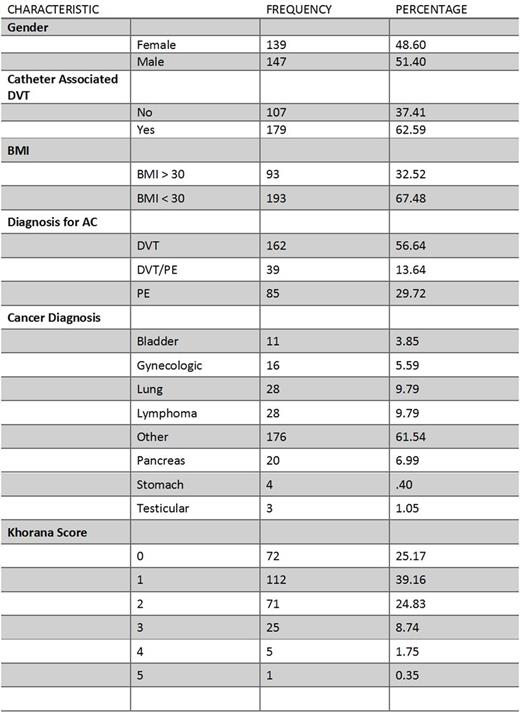Abstract

BACKGROUND:
Venous thromboembolism is a well-known complication of malignancy. The Khorana Risk Score (KRS) utilizes the type of cancer, blood counts, and body mass index to predict risk of thrombosis in cancer patients. Patients with a KRS of greater than 3 are considered high risk for developing blood clots and may benefit from prophylactic anticoagulation. We wanted to determine if the use of the KRS would have led to prophylactic anticoagulation (AC) in these cancer patients prior to their thrombotic events.
METHODS:
This study utilized a group of 286 patients treated at Moffitt Cancer Center between May 1, 2010 and June 30, 2015 with a wide variety of cancer diagnoses with known venous thromboembolic events (VTE) (pulmonary embolism or deep venous thrombosis). We aimed to validate the KRS by retrospective analysis to determine if the KRS would have predicted VTE in these patients on the day of their venous thromboembolic event. The demographics are summarized using descriptive statistics. Wilcoxon rank-sum test is used for testing the difference in continuous variables. Fisher exact test is used for testing the difference in categorical variables.
RESULTS:
We found that the majority of these cancer patients with known VTE (89%) would have been classified as low risk of having VTE. Only 11% would have been classified as high risk to where prophylactic anticoagulation might have been indicated.
CONCLUSIONS:
We found that in a diverse group of cancer patients who had thrombotic events, the KRS did not appropriately stratify patients at the highest risk of VTE. The majority of patients with VTE were actually found to be low risk which would not have led to improved awareness or medication prophylaxis. Improved risk stratification methods are needed for cancer patients to implement an effective prophylactic strategy.
No relevant conflicts of interest to declare.
Author notes
Asterisk with author names denotes non-ASH members.

This icon denotes a clinically relevant abstract


This feature is available to Subscribers Only
Sign In or Create an Account Close Modal